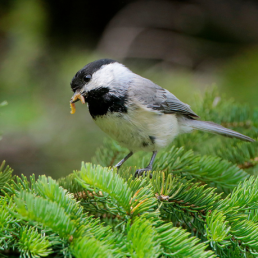

Join BirdNote tomorrow, November 30th!
Illustrator David Sibley and actor H. Jon Benjamin will face off in the bird illustration battle of the century during BirdNote's Year-end Celebration and Auction!
Congratulations to every photographer who participated in BirdNote's 18th Birthday Photo Contest! We were absolutely blown away by your talent and your ability to showcase the wonder of birds through photography. Browse the 1st, 2nd and 3rd place winners below!
First Place: Heather Roskelley

Whooping Cranes, taken in Aransas National Wildlife Refuge, Austwell, Texas. Here's what Heather says about this photo:
I stayed in Rockport, close to where Captain Tommy Moore conducts Whooping Crane tours on his boat Skimmer in the intercoastal bays of Aransas National Wildlife Refuge. We saw many “whoopers” and other Gulf Coast water birds and shorebirds. The most thrilling moment came when three subadult Whooping Cranes flew at eye-level next to our boat. They were so big and close that I quickly pulled in my 400mm lens to 80mm and hoped that I captured something decent. Standing nearly five feet tall, Whooping Cranes are the tallest bird in North America and one of the rarest. Their numbers were reduced to as few as 15 in 1941, but now number 500-strong on the Texas Gulf Coast due in part to federal protection under the Endangered Species Act. These Whooping Cranes winter in the Aransas National Wildlife Refuge area and travel 2,500 miles by mid-April to nest in Wood Buffalo National Park in the Northwest Territories of Canada. They’re very territorial, so when one sees a group of three or more with adult plumage, they’re usually subadults like these birds – aged two to four years.
Second Place: Jocelyn Anderson

Sandhill Crane family, taken in Milford, Michigan. Here's what Jocelyn says about this photo:
As I was walking along the nature trails on a Spring day, I saw a family of Sandhill Cranes with two colts making their way nearby on a grassy path. The colts looked to be about a week old and very new to the world. The parents were plucking invertebrates from the tall grasses to feed to the young ones as they continued on their morning walk. Several hawks and snapping turtles prowl the park but the parents with their spear-like beaks do an excellent job of keeping their colts safe.
Third Place: Michelle Talich

Peregrine Falcon, taken in Coney Island, Brooklyn, NY. Here's what Michelle says about this photo:
This photo was taken at Coney Island on January 26, 2023. The day was relatively warm but it was brutally windy. My friend and I were trudging along the beach towards the subway to head home when we spotted this Peregrine Falcon standing on the beach being pummeled by sand. The bird weathered the gusts by putting her head down and half-closing her eyes. Whenever the wind died down a bit, she would look around and watch the pigeons and gulls flying by while opening and closing her beak - I'm sure she had sand in her mouth! We watched her for several minutes (being pummeled by sand ourselves) until she finally took off and flew further down the beach. This photo captures the moment right before she took off. In the background is the colorful base of the old Parachute Jump, a ride that was moved to Coney Island from the World's Fair site in 1941 and operated until the 1960's. Peregrines can often be seen perched atop the Parachute Jump and the remains of their meals can sometimes be found littering the boardwalk below. On this day, the wind must have been intolerable 262 feet up in the air which may be why this peregrine chose to hang out down on the beach instead. You can that this bird is banded - peregrines are listed as an endangered species in NY State. I reported the band codes to the Federal Banding website and learned that this falcon is a female and she was bended when she was too young to fly in May 2022 somewhere nearby in NY State. Such a beautiful young bird! I hope to see her again.
